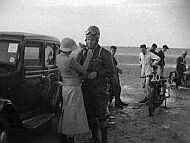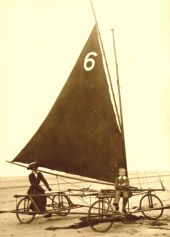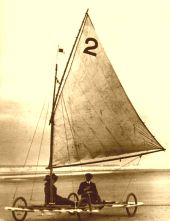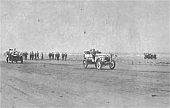Discovering Saltburn's rich heritage and varied history.
Speed Trials on the sands at Saltburn by the Sea
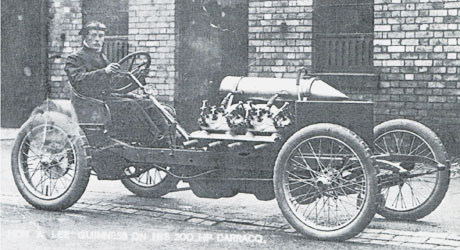
Round the last Boulby headland is a green crumble of cliff-top and then the high but still magnificent table-top of Huntcliff. It is one of the highest cliffs in England. It thrusts out long and rough. A hazard of red boulders at its feet runs out into a long shambles of rock.
Then the sands begin, sweeping north for over six miles. They are the 'finest in England', white, wide, empty, silken, safe. At low tide they are wet and sculpted in ridges, flashing with salt pools,glittering in places with brush-strokes of shiny black sea-coal. The wind hurtles over them and mile-long snakes of fine, stinging white sand blow like smoke just above their surface. On windless days, a bluish light reflects in them. They are the sands of the 'Walrus and the Carpenter' which Lewis Carroll is said to have written after a day here with friends during a long vacation from Oxford.
Jane Gardam, 'The Iron Coast' 1994
The miles of flat sands at Saltburn have provided the visitor with a number of different pastimes - cricket, sand sculptures and donkey riding have all played their part. In the early 1900's the more adventurous looked upon the beach with a different perspective with the pursuit of excitement and speed as their goal.
Speed Trials
In the early part of the 20th century, Saltburn boasted five miles of hard, flat, smooth sands which were several hundred feet wide at low tide.
It was in July 1904 that they were first considered for use for motor racing and the following year the first run on the sands was made by L.R. Anderson.
On July 14th 1906, the Yorkshire Automobile Club organised the first Motor Races and Speed Trials to be held at saltburn. 60,000 spectators watched as Warrick Wright set a Yorkshire record of 96.5mph, although the real star of the day was probably W Ashford, whose 15hp steam car reached 54mph. There were six events in all, the final one being for touring cars which was won by Mr A Farnell with his 30hp Daimler
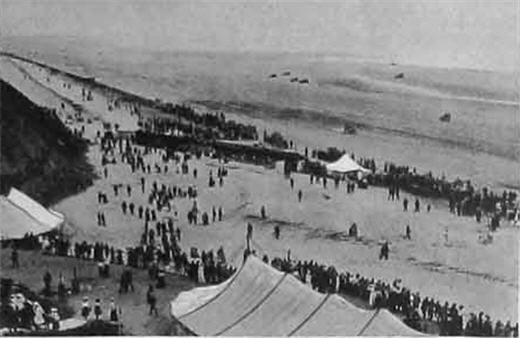
General view of the course, viewed from Hazelgrove, for the 1906 speed trials.
The following year saw the arrival of Algernon Lee Guinness, the brewery heir, with the world's fastest car - a French-made 200hp Darracq with an impressive missile-shaped tank tied to the top of its engine. Lee Guinness - "Algy" to his friends - was up against a Dietrich which belonged to the Maharajah Tikara.
Although it was June the Northern Echo reported that "The heavy rain had made the sands wet and heavy but with a whirr and a flash the cars went by appearing to almost rival the streaks of forked lightning which a few minutes before had flashed across the sky." The Maharajah's motor barely moved but Algy reached "a marvellous speed" of 111.84mph - an unofficial English record
The following year, because of the tides, the trials took place in the early morning. Again thousands of spectators watched as Algy Guinness once again raced across the firm dry sands between Marske and Saltburn to equal the British record of 121.6mph.
In 1909, he was back again with his Darracq. The weather was again dreadful but Algy scorched across the sodden sands: AW Tate came second, his Mercedes reaching 92.43mph. Despite the fact that Algy only clocked 120.26mph compared to his 1908 run it was strangely described as an English record.
After his final run, Algy examined his engine and noticed that piston number six had cracked. The Darracq was taken home, dumped in the garage and Algy bought other, faster vehicles. Eventually he sold the Darracq to a dealer, but got cold feet days later. Unfortunately the dealer had started dismantling and all that was left was its V8 engine. The engine passed through various hands and has recently been restored. In April 2006 it was fired up for the first time since its last race at Saltburn and it appeared once again on the sands here on September 19th 2009.
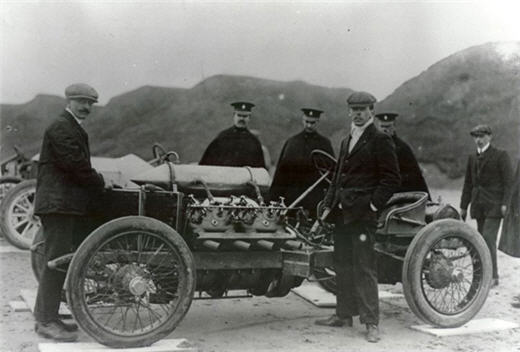
Algy Lee Guinness with his brother Kenneth (left) and the Darracq 200 on Saltburn Sands 1907-09
- 1907 June 22 Saltburn speed trials Yorkshire record flying kilometre 111.84 mph
- 1908 June 28 Saltburn British & European record flying kilometre 121.57 Equals world record
- 1909 June 26 Saltburn FTD flying kilometre 120.25
In the years before the First World War, when a car manufacturer wanted more horsepower, they just built a bigger engine. Fiat was one of the leading makes of the time, and had been successful in racing with their S61 and S74 models, the S74 having a four cylinder engine of around 14 litres. The concept of the Land Speed Record was not yet established, but the world records for the flying kilometre and flying mile were highly prized. In 1911 the enormous 'Blitzen' Benz of over 21 litres held both these records, and Fiat decided to attack them with the S76.
In 1911 Fiat tried the car out at Brooklands, then took it to the sprint event at Saltburn Sands. The driver, Pietro Bordino, spurned the idea of putting the car on a trailer and drove it from Brooklands to Saltburn on the public highway – a 300 hp racing car with stub exhausts belching several feet of flame at passers-by. The intrepid passenger reported that on the journey the speedo sometimes read over 120 mph. At Saltburn, although the sand was damp and hence slow, the Fiat captured the flying mile record at a mere) 116 mph, but Fiat were happy and saw no need to make further use of the car.
The First World War interrupted the events and it wasn't till July 1920 that the events recommenced.
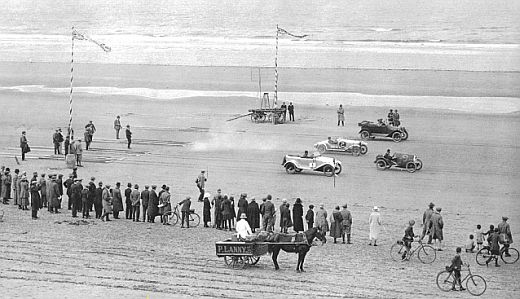
In 1922 Malcolm Campbell raced here in an Austro Daimler and won the event for cars up to 2,500cc. More importantly, Campbell also borrowed the Louis Coatalen 350hp Sunbeam and brought it to Saltburn determined to set his first land speed record. This same car then held the current record at 133.75mph when Lee Guinness drove it at Brooklands on 17th May 1922. Campbell believed that without the restrictions of the banking that was at Brooklands he could set a faster speed on the sands. On his first run on 17th June 1922 he roared down the two mile run up before entering the measured mile and achieved 130.6mph. The return run achieved a faster speed at 134.76mph despite being into the wind and having narrowly to miss a dog that suddenly appeared on the beach. Campbell went on to complete six runs, ending the day with a record of 138.08mph and his first land speed record. However, this was not recognised by the international body, The Commission Sportive, in Paris, could not approve the figures as the Yorkshire Automobile Club timekeepers had used hand-held stopwatches instead of the electrical timing apparatus required by the official rules. This was the first time the authorities failed to accept one of Campbell's records and unfortunately it was not to be the last.

By 1938 the Saltburn sands were no longer considered suitable for racing and the sands further to the north at Redcar and Coatham were used instead although they were not as good as there were wet and dry patches. The Second World War interrupted the racing and it wasn't till 1946 when the beaches were completely cleared of barbed wire and mines that racing could begin again.
In 1948 Bob Berry raced here with his motorcycles and 1955 saw the last mixed motorcycle and car race meeting at Redcar. In 1962, some local bike racers formed the Tees-Tyne Motor Cycle Sand Racing Club with special permission to race obtained from the Local Authority and the first event was held on 8th September 1962. There was a further event in 1963 but this was only followed by a few more. The sands had deteriorated and there was no suitable stretch of flat, hard sand to use for high speed racing, a condition which still remains today.
A Brief History of Saltburn Beach Racing from Fridge Productions on Vimeo.
Author, motor historian and Middlesbrough Motor Club Hill Climb organiser, Ernie Crust describes the origins and development of speed racing on the sands at Saltburn and Marske.
Mr Mark Walker with his 1905 Darracq , and Mr Neil Tuckett in his 1911 Mod T.Ford. Mr Walkers Darracq set the land speed record in 1908 driven by a Sir Algernon Lee Guinness, and set a speed of 121.57 mph on Saltburn sands.
Research by Rebecca Hilton. Collecting primary source materials, articles and extracts from books related to the development of both Saltburns and trying to validate them has offered conflicting information, much of which is often difficult to validate as many sources can prove to be unreliable e.g. newspapers or census data. Every effort has been made to ensure that the information on the history of the town presented here is as accurate as possible.

